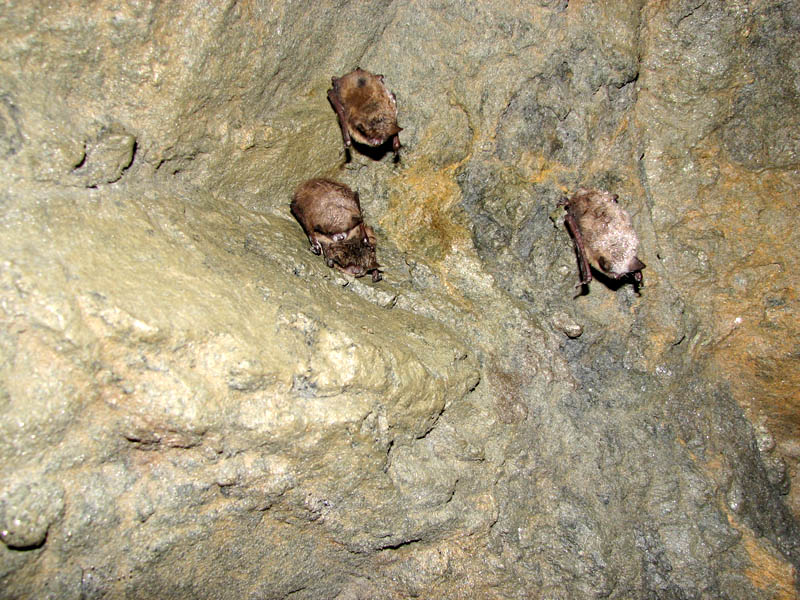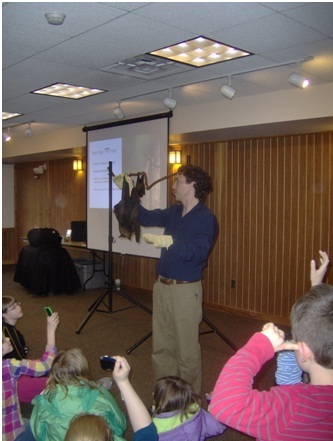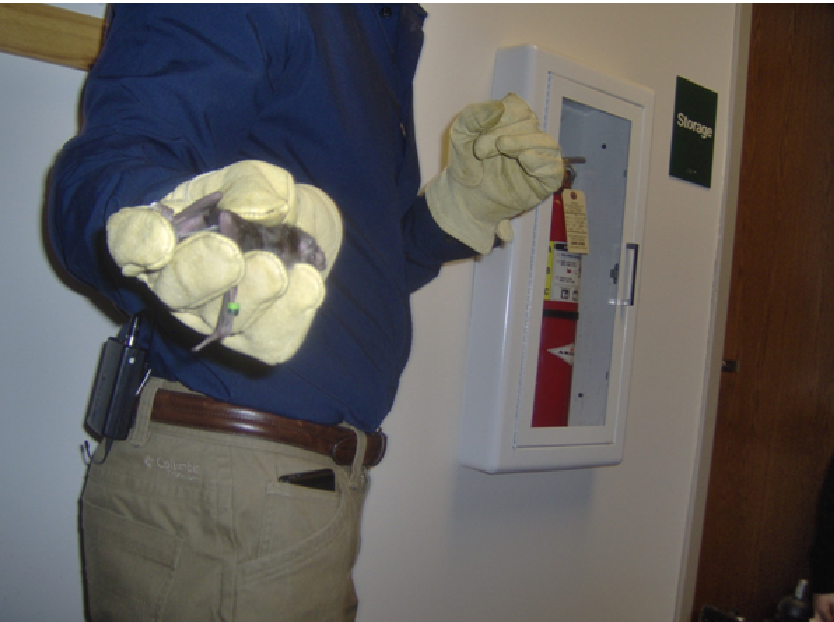On a blustery, frigidly cold day in mid-April, a small gathering of cub scouts from one of several local packs congregated outside the Lussier Heritage Center on the southern end of Madison for the annual bat festival. They had braved the elements to see these furry creatures, perhaps for the first time in their lives, and to put aside the myth that they are little more than Transylvanian-born vampiric vermin. The cub scouts had come to hear the experts talk. And there could have been no better person for the job of getting the education process started than conservationist Rob Mies- indisputably the star of this year’s bat show.
Mies boasts an impressive list of guest appearances on nightly television venues including The Tonight Show, Late Night with Conan O’Brien, The Today Show, Live with Regis and Kelly, Martha Stewart Living, and the CBS Early Show. Such appearances have earned him the title of ‘the bat man’ in media circles. He is the director, and founder of the Organization for Bat Conservation and has spent a great deal of time studying bats out in the field (in contrast to my split-second encounters, watching small fruit bats flap by the windows of my boarding school dorm).
Having settled down in one of the quaint lecture rooms on the lower floor of the Lussier center, our cub pack turned its attention towards Mies who had brought live specimens of several bat species with him including a brown bat, vampire bat and a flying fox affectionately called Camila. He delivered the facts in a fashion that was easily digestible for the uninitiated mind, mine included while mingling confidently with the audience with each bat hanging from his glove-protected hands. Several of the key facts he shared with us stand out in my mind. Worldwide there are 1100 different types of bat categorized as either ‘microbats’ or ‘macrobats’ depending on size (small and large respectively). Their life spans range from 20 to 30 years. Some are known to eat about 1-2 times their weight in insects daily. They have a particular delight for beetles and moths which of course makes them efficient agents for agricultural pest control.
During the winter months bats hide in caves, attics, barns or migrate to warmer climes, sometimes traveling over vast distances as part of their migratory behaviors. Roost fidelity—the ability to return to the same location year after year- is very high amongst migrating species. Using satellite tracking some African species have been observed to cover over 1000 miles in as little as 2 months—no easy feat for the world’s only flying mammals. Macrobats tend to be fruit eaters that can eat about twice their weight in fruit. They echolocate at a frequency of 30-35 KHz. Since humans are tuned to hear at 18 KHz, Mies needed to use an ultrasonic detector to make the incessant clicking of his bats audible to the human ear. And that wasn’t the only thing that was racing in the room. Incredibly the heart rates for most bats range from 300 to 600 beats per minute during rest, doubling that during flight. These same bats can reach tens of grams in body weight and sport exquisite wings that are not dissimilar in thickness to a human eyelid. Brown bats, which are native to the United States, have wing spans of approximately 12-14 inches and weigh as little as 20 g (4 nickels). They have one baby a year. And their most endearing qualities (at least for the children in the audience, who tended to notice such things) are their small eyes and big ears.
Mies entertained a flurry of questions across a broad knowledge spectrum as he walked around the room with his bat collection. He pointed out how bats have special blood pumping systems that helps them cope with the problems associated with living upside down. They are the only flying mammal. Vampire bats, native to Central and South America, have heat-sensing organs that allow them to home in on veins under the skin of their would-be victims. They will scratch the surface of the skin- usually the hides of cows and other farm animals- and drink 1-2 teaspoons of blood at a sitting. When in captivity they are fed blood collected from cows as a byproduct of the slaughter process.

Camila, an 18-year old fruit eating Gigantic Flying Fox, was the largest bat in Mies’ collection. Considered to be the largest species of bat in the world, the Flying Fox is facing extinction because of deforestation in its native islands in the Philippines. Indeed as with much of our natural heritage there are significant global threats to the wellbeing of bats in general. A lack of appreciation of the benefits they provide and a misunderstanding of their habits mean that many are injured each year by humans. Broken wings are not uncommon. And this is part of the reason why conservation organizations such as the one that Mies is heading are vital for their continued existence. Recent years have also brought a steady increase in the number of reported cases of White Nose Syndrome, a fungal borne disease that has killed hundreds of thousands of bats, mainly in the northeastern United States. Data shows that the disease is most prevalent during winter months when bats actively seek sheltered enclaves, caves and attics for example, in which to hibernate. Brown bats are the most seriously affected. And laboratories across the United States have actively studied dead specimens in an attempt to better understand the causative agents. The extensive use of non-agricultural pesticides and rampant global warming are two factors that are believed to exacerbate the spread of the disease although the pathology of White Nose Syndrome is still poorly understood. Currently there are no known antidotes.
Fortunately the often tenuous relationship between humans and bats is not all doom and gloom. Throughout his talk Mies stressed that there is much that we can do to proactively help bats that have taken residence in our own communities. One idea that appealed to the younger section of the audience is the bat house. The web store on Mies’ own bat conservation website carries instruction manuals for building these rather simple wooden structures some of which can house as many as 300 bats at a time. Mies most certainly has a passion for all things bat-related. One can only be thankful that he has taken the time to become a devoted ‘bat man’, eager as he is to stamp out the misgivings that people have for these creatures in our own Gotham city of unfamiliarity.
Robert Deyes
Latest posts by Robert Deyes (see all)
- Royal Lessons for Scientific Discovery - October 28, 2016
- Because Timing Is Everything…. - August 18, 2014
- Grays On the Move: Whale Watching in San Diego - April 30, 2014



Great review of the real Batman. Next stop: Gotham, WI, and the Bat Cave on State Road 60!